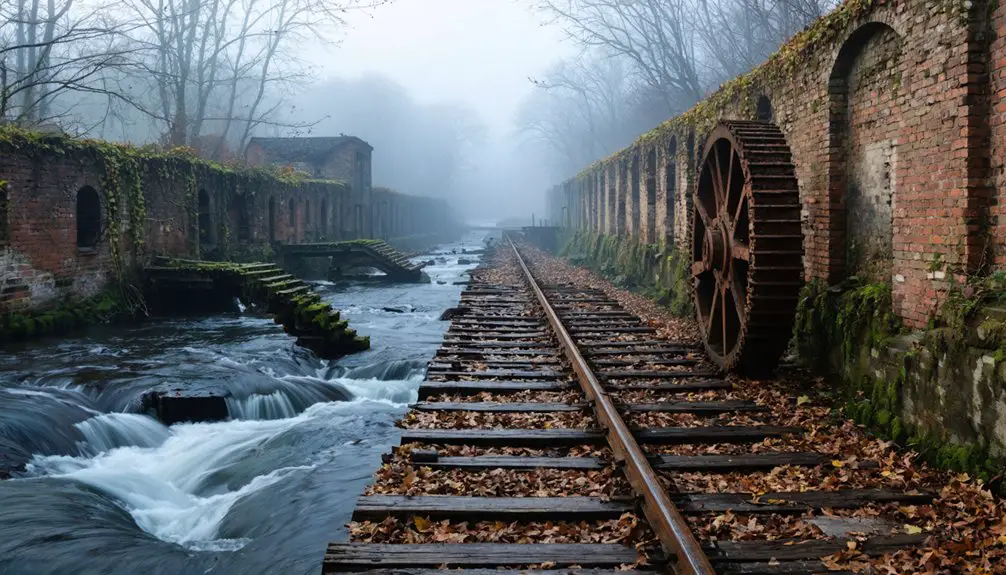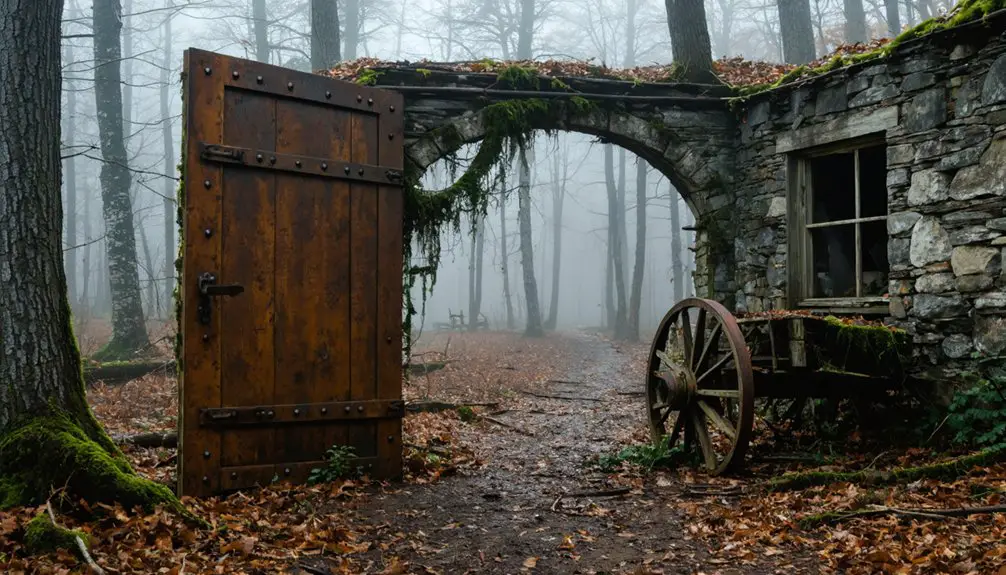You’ll find West Waterford’s transformation from bustling village to ghost town began in the early 1900s when the New England Power Company started buying local properties. By 1926, the Connecticut River Development Company‘s land acquisitions forced families to abandon their homes. The flooding from hydroelectric projects submerged significant portions of this once-thriving farming and industrial settlement. The area’s rich history, from Indigenous Mohican settlements to haunting tales, holds many more fascinating secrets.
Key Takeaways
- West Waterford transformed from a thriving settlement to a ghost town after New England Power Company began acquiring properties in the early 1900s.
- The local post office closed in 1905, marking the beginning of the community’s decline as residents started abandoning their homes.
- Connecticut River Development Company’s land purchases in 1926 accelerated the town’s abandonment and economic decline.
- Hydroelectric projects flooded significant portions of the original settlement, submerging historical buildings and sites underwater.
- The town’s ghostly reputation stems from disturbed cemetery graves, relocated headstones, and reported hauntings linked to Indigenous peoples and soldiers.
The Birth of a Vermont Village
While indigenous Mohicans originally cultivated the land until the early 1700s, West Waterford’s formal beginnings emerged from the Van Schaick Patent of 1664, which established colonial claims to the area.
The village origins took shape near the Connecticut River, where fertile soil and abundant natural resources attracted early settlers. You’ll find the community evolution marked by the arrival of pioneering families – the Carpenters in 1808 and the Hoveys in 1803. The village was centered around Duck Pond Road, which served as the main thoroughfare for local residents. The Carpenter family became influential in local affairs, with Amos B. Carpenter serving as the village’s postmaster.
The settlement gained official recognition when it became a postal village on January 5, 1856. Early West Waterford thrived on farming, fur trading, and fishing, with the river playing an essential role in shaping the community’s development.
The village’s strategic location near dams on the Connecticut River would later influence its destiny.
Early Settlers and Community Life
If you’d visited West Waterford before 1900, you’d have found pioneering families like the Bucks, Cutlers, Pikes, and Hutchinsons working their farms and contributing to a tight-knit agrarian community.
These early settlers, who’d migrated together from northeastern Massachusetts towns like Athol and Ashburnham, initially lived in log houses before building more substantial Cape Cod-style homes with distinctive ells. The area became one of several important original town districts that helped establish Waterford’s early community structure. Amasa Hastings was the first settler to establish himself in this part of town.
You’d have witnessed a largely self-sufficient economy where farming, particularly dairy operations, formed the backbone of daily life, supplemented by essential trades and crafts that served the rural Vermont community.
Pioneering Farm Families’ Legacy
As pioneers ventured from Worcester County and other Massachusetts regions in the early 1800s, West Waterford’s founding families established deep-rooted agricultural communities along the Connecticut River. The town’s fertile soil quality made it particularly well-suited for successful farming operations.
You’ll find settler connections woven through families like the Bucks, Cutlers, and Richardsons, who transformed untamed wilderness into thriving farmsteads.
These pioneering families left lasting family legacies through:
- Log homes that evolved into Cape-style houses with distinctive extensions
- Intermarriage networks that created tight-knit farming communities
- Agricultural traditions that shaped the region’s social fabric
The influential Buck family, led by Reuben Buck, exemplified this pioneer spirit by acquiring significant land holdings and forming essential alliances through marriage.
This network of determined farming families created distinct districts, including the iconic “White Village” that would later become a cultural centerpiece of Lower Waterford.
Daily Life Before 1900
Life in West Waterford before 1900 centered around tight-knit farming communities established by these pioneering families. You’d find your neighbors living in log cabins or Cape-style homes with ells, strategically built near water sources and fertile soil.
Your daily routines would revolve around tending crops like corn and beans, caring for livestock, and maintaining your homestead.
Community gatherings were essential to survival and social bonds. You’d join forces with neighboring families for cooperative farm work, sharing labor and resources.
In the White Village of Lower Waterford, you’d attend meetings at the town hall, visit the library, or participate in religious observances.
Family networks, often connected to northern Massachusetts roots, formed the backbone of social life, with relatives settling near one another and working together to overcome frontier challenges.
Economic Foundations and Local Trade
You’ll find that West Waterford’s economic foundation rested firmly on agriculture, with farming serving as the primary economic driver throughout the 19th and early 20th centuries.
The village’s market activities centered around supporting the farming community through associated trades and services, creating a self-sustaining local economy in the “White Village” area.
Local transport routes connected West Waterford’s agricultural producers to broader markets, though this economic stability would later be challenged by land sales to power companies in the early 20th century.
Early Farming Practices
While many Vermont towns flourished through diverse industries, West Waterford’s economic foundation rested primarily on farming for over three centuries. You’d have found a landscape dominated by dairy operations, with Vermont hosting 290,000 dairy cows by 1920. Local farmers often traded their goods at the general store, which operated alongside other village establishments until the 1930s.
Farmers practiced careful livestock management, maintaining diverse animal populations including horses and pigs alongside their dairy herds. The Dussault family managed their 233-acre farm on Fairbanks Mountain, reflecting the typical size of local agricultural operations.
- Farmers relied on traditional haying methods, using manual rakes and following strict seasonal cycles.
- Crop rotation and livestock feed production centered around the massive hay requirements for dairy cattle.
- Family farms operated through generations, passing down agricultural knowledge and techniques.
The agricultural rhythm was marked by year-round activities, with haying recorded as early as 1645. This meticulous approach to farming sustained West Waterford’s economy until reservoir construction began changing the landscape.
Trade Routes and Transport
Situated at a critical crossroads of New England commerce, West Waterford’s trade networks centered on Route 18’s essential corridor between Portland and Burlington, with the Connecticut River serving as a parallel commercial artery. Several merchants utilized the nearby Lake Champlain route for cargo transport.
You’d find the transport evolution reflected in the town’s diverse vehicle arsenal – from horse-drawn Concord wagons to early motorized transport.
Local farmers relied on carts and sleighs adapted to steep terrain and seasonal conditions. The Lebrun farm purchase in 1914 included various wagons essential for agricultural operations. Trade dynamics revolved around dairy operations, with creameries functioning as crucial economic hubs.
Timber transport kept one-horse lumber wagons busy, while agricultural products moved steadily through established routes to regional markets.
Village Market Activities
At the heart of West Waterford’s economic importance stood its woolen mills, which transformed locally sourced sheep wool into marketable products while providing steady employment for villagers.
The village commerce revolved around these mills, creating a dynamic marketplace where farmers, artisans, and merchants converged to trade goods and services. With company stores operating in the area, workers often circulated their wages back into the local economy.
You’d find market dynamics shaped by seasonal agricultural patterns and the steady flow of manufactured items.
- Local stores and post offices served as vibrant social centers where villagers exchanged goods, information, and conducted both cash and barter transactions.
- Agricultural trade dominated daily life, with dairy farms and sheep operations providing raw materials for the mills and food for the community.
- Small-scale manufacturers produced specialized items like iron castings, wood veneers, and machinery parts that connected West Waterford to broader regional markets.
The Coming of Industrial Change

As West Waterford entered the industrial age in the early 1840s, sawmilling emerged as the region’s dominant enterprise, soon followed by ironworking and specialized manufacturing.
You’d have seen the industrial evolution unfold as factories produced everything from steam car wheels to fire engines, with John F. Rogers’ patent hand pumps gaining prominence in the 1830s.
The region’s economic shifts became evident as veneer production took hold, shipping millions of feet of exotic woods worldwide.
These changes transformed the landscape, as factories clustered along the river, surrounded by working-class housing and support businesses.
You’d have witnessed how technological advancements reshaped the community, though successive fires and the Moore Dam project in the 1930s eventually led to the displacement of the Upper Village’s industrial heart.
From Thriving Settlement to Ghost Town
The once-bustling settlement of West Waterford began its decline in the early 1900s, when the New England Power Company started acquiring local properties between 1906 and 1910.
You’ll find evidence of the declining population in the discontinuation of the local post office by 1905, marking the loss of essential community services.
The transformation into a ghost town unfolded through these stark changes:
Like scattered leaves in autumn’s wake, the town faded away through waves of progress and industrial priorities.
- Families abandoned their homes as the Connecticut River Development Company bought up land in 1926
- Economic sustainability crumbled when railroad transport made traditional teaming and staging obsolete
- Hydroelectric projects led to flooding that submerged significant portions of the settlement
Historical Legacy and Paranormal Tales
Layered beneath West Waterford’s ghost town ruins lies a complex historical tapestry spanning Indigenous settlements, colonial fortifications, and early American development.
You’ll find historical hauntings tied to each era: spirits of Indigenous peoples near ancient burial grounds, phantom French soldiers from the burned fort, and British specters haunting their military post’s remains.
When you explore Waterford’s supernatural legends, you’ll discover they’re deeply rooted in documented events.
The disturbance of old cemetery graves during street paving and the relocation of headstones have fueled persistent paranormal reports. The flooding of original village sites by dam construction between 1926-1953 added another dimension to these ghostly tales.
Today, the Historical Society preserves these stories, while the Rabbit Hill Inn stands as a tangible link to this haunted past.
Frequently Asked Questions
Are There Any Accessible Ruins or Structures Still Visible in West Waterford?
You’ll find the Cutler House at 6888 Route 18 remains accessible, featuring preserved post-and-beam construction and visible ruins like its cement stoop, though fire damage marks its eastern elevation.
What Happened to the Original Artifacts From West Waterford Homes?
Millions of precious artifacts disappeared into private hands when residents relocated. You’ll find that most household items were either taken by owners or lost during demolition and flooding—virtually no formal preservation occurred.
Did Any Families Receive Compensation When Forced to Relocate?
You won’t find documented evidence of formal relocation benefits or family compensation in historical records, though some residents likely received payment through private land sales to development companies.
Which Native American Tribes Originally Inhabited the West Waterford Area?
You’ll find the Western Abenaki tribe’s heritage dominated this region, as their tribal influence extended throughout northern Vermont’s Connecticut River Basin, where they maintained settled communities and traditional hunting grounds.
Are There Any Annual Events Commemorating West Waterford’s History?
You won’t find any historical reenactments or community gatherings specifically commemorating this site’s past. Despite Vermont’s rich tradition of fall festivals and haunted events, none are dedicated to West Waterford’s story.
References
- https://www.youtube.com/watch?v=il-BaexRrRM
- https://sites.rootsweb.com/~vtcbarne/UpperWaterford.htm
- https://waterfordvt.gov/town-history.html
- https://waterford-vt-history.blogspot.com/2014/02/west-waterford-village-that-once-was.html
- https://outside.vermont.gov/agency/ACCD/ACCD_Web_Docs/_Drupal 7 ACCD Website Document Library/documents/Historic Preservation/6888 Route 18_Cutler House History Report.pdf
- https://dos.ny.gov/town-and-village-waterford-section-ii-inventory-and-analysis
- https://www.nrc.gov/docs/ML0419/ML041910421.pdf
- https://waterford-vt-history.blogspot.com/2015/
- https://local.caledonianrecord.com/waterford-vt/town-of-waterford-vermont-802-748-2122
- https://waterford-vt-history.blogspot.com/2017/09/rediscovering-settled-life-along.html



